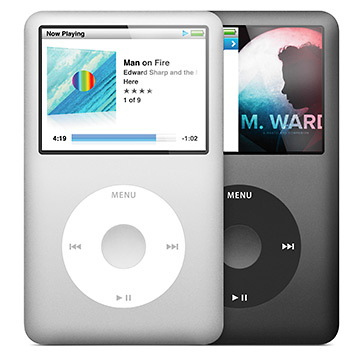Televisions in the early days used to be hot, heavy, power-hungry entertaining machines that sat in the corner of your living room. It isn’t like that anymore! Now they’re slim enough to hang on the wall and they use a fraction of energy of their ancestors. Like laptops, mostly new televisions have flat screens with LCDs (liquid-crystal displays) the same technology we’ve been using from years in displays like calculators, digital watches and phone screens. So how do they work? Let’s take a look!

Photo: Small LCDs like them have been widely used in calculators and digital watches since long time.
How does a television (T.V) make its picture?

Photo: This music player is an example of LCD display technology.
Most people are attracted to LCD for their flatness rather than their picture quality, it can be hung on the wall because of its flatness. Unlike their predecessors, they are not bulky and quite portable when compared to CRT display sets.
An old-style Cathode Ray Tube (CRT) makes a picture using three electron guns.
Flat screen LCD and plasma screens work in a completely different way. If you sit up close to a flat screen TV, you’ll notice that the picture is made from millions of tiny blocks called <strong>pixels</strong> (picture elements). Each one of these is effectively a separate red, blue, or green light that can be switched on or off very rapidly to make the moving color picture. The pixels are controlled in completely different ways in plasma and LCD screens. In a plasma screen, each pixel is a tiny fluorescent lamp switched on or off electronically. In an LCD television, the pixels are switched on or off electronically using liquid crystals to rotate polarized light. That’s not as complex as it sounds! To understand what’s going on, first we need to understand what liquid crystals are; then we need to look more closely at the light and how it travels.
What are liquid crystals?

Photo: Liquid crystals dried and viewed through polarized light.
We’re used to the idea that a given substance can be in one of three states: solid, liquid, or gas we call them states of the matter and up until the late 19th century, scientists thought that was the end of the story. Then, in 1888, an Austrian chemist named Friedrich Reinitzer (1857–1927) discovered liquid crystals, which are another state entirely, somewhere in between liquids and solids. Liquid crystals might have lingered in obscurity but for the fact that they turned out to have some very useful properties.
Solids are frozen lumps of matter that stay in the same place all by themselves, often with their atoms packed in a regular arrangement called crystal(or crystalline lattice).
Liquids lack the order of solids and, though they stay put if you keep them in a container, they are always looking for a chance to flow out of that container. Now imagine a substance with some of the order of a solid and some of a liquid. What you get is a liquid crystal—a kind of halfway house in between. At any given moment, liquid crystals can be in one of several possible “substrates” (phases) somewhere in a limbo-land between solid and liquid. The two most important liquid crystal phases are called nematic and smectic.
- When they’re in the nematic phase, liquid crystals are a bit like a liquid: their molecules can move around and shuffle past one another, but they all point in broadly the same direction. They’re a bit like matches in a matchbox: you can shake them and move them about but they all keep pointing the same way.
- If you cool liquid crystals, they shift over to the smectic phase. Now the molecules form into layers that can slide past one another relatively easily. The molecules in a given layer can move about within it, but they can’t and don’t move into the other layers (a bit like people working for different companies on particular floors of an office block). There are actually several different smectic “sub-phases,” but we won’t go into them in any more detail here.
What is polarized light?
Nematic liquid crystals have a really neat party trick. They can adopt a twisted-up structure and, when you apply http://www.explainthatstuff.com/electricity.html electricity to them, they straighten out again. That may not sound much of a trick, but it’s the key to how LCD displays turn pixels on and off. To understand how liquid crystals can control pixels, we need to know about <strong>polarized light</strong>.
Light is a mysterious thing. Sometimes it behaves like a stream of particles—like a constant barrage of microscopic cannonballs carrying http://www.explainthatstuff.com/light.html energy we can see, through the air, at extremely high speed. Other times, light behaves more like waves on the sea. Instead of water moving up and down, light is a wave pattern of electrical and magnetic energy vibrating through space.

A trick of the polarized light: rotate one pair of polarizing sunglasses past another and you can block out virtually all the light that normally passes through.
When sunlight streams down from the sky, the light waves are all vibrating in every possible direction. But if we put a filter in the way, with a grid of lines arranged vertically like the openings in prison bars (only much closer together), we can block out all the light waves except the ones vibrating vertically (the only light waves that can get through vertical bars). Since we block off much of the original sunlight, our filter effectively dims the light. This is how polarizing sunglasses work: they cut out all but the sunlight vibrating in one direction or plane. Light filtered in this way is called polarized or plane-polarized light (because it can travel in only one plane).
If you have two pairs of polarizing sunglasses (and it won’t work with ordinary sunglasses), you can do a clever trick. If you put one pair directly in front of the other, you should still be able to see through. But if you slowly rotate one pair, and keep the other pair in the same place, you will see the light coming through gradually getting darker. When the two pairs of sunglasses are at 90 degrees to each other, you won’t be able to see through them at all. The first pair of sunglasses blocks off all the light waves except ones vibrating vertically. The second pair of sunglasses works in exactly the same way as the first pair. If both pairs of glasses are pointing in the same direction, that’s fine—light waves vibrating vertically can still get through both. But if we turn the second pair of glasses through 90 degrees, the light waves that made it through the first pair of glasses can no longer make it through the second pair. No light at all can get through two polarizing filters that are at 90 degrees to one another.
How LCD televisions use liquid crystals and polarized light

Photo: How liquid crystals switch light on and off. In one orientation, polarized light cannot pass through the crystals so they appear dark (left side photo). In a different orientation, polarized light passes through okay so the crystals appear bright (right side photo).
An LCD TV screen uses the sunglasses trick to switch its colored pixels on or off. At the back of the screen, there’s a large bright light that shines out toward the viewer. In front of this, there are millions of pixels, each one made up of smaller areas called sub-pixels that are colored red, blue, or green. Each pixel has a polarizing glass filter behind it and another one in front of it at 90 degrees. That means the pixel normally looks dark. In between the two polarizing filters, there’s a tiny twisted, nematic liquid crystal that can be switched on or off (twisted or untwisted) electronically. When it’s switched off, it rotates the light passing through it through 90 degrees, effectively allowing light to flow through the two polarizing filters and making the pixel look bright. When it’s switched on, it doesn’t rotate the light, which is blocked by one of the polarizers, and the pixel looks dark. Each pixel is controlled by a separate transistor (a tiny electronic component) that can switch it on or off many times each second.
How colored pixels in LCD TVs work?
There’s a bright light at the back of your TV; there are lots of colored squares flickering on and off at the front. What goes on in between? Here’s how each colored pixel is switched on or off:
How pixels are switched off
- Light travels from the back of the TV toward the front from a large bright light.
- A horizontal polarizing filter in front of the light blocks out all light waves except those vibrating horizontally.
- Only light waves vibrating horizontally can get through.
- A transistor switches off this pixel by switching <em>on</em>the electricity flowing through its liquid crystal. That makes the crystal straighten out (so it’s completely untwisted), and the light travels straight through it unchanged.
- Light waves emerge from the liquid crystal still vibrating horizontally.
- A vertical polarizing filter in front of the liquid crystal blocks out all light waves except those vibrating vertically. The horizontally vibrating light that traveled through the liquid crystal cannot get through the vertical filter.
- No light reaches the screen at this point. In other words, this pixel is dark.
How pixels are switched on?

Image result for how pixels are switched on
- The bright light at the back of the screen shines as before.
- The horizontal polarizing filter in front of the light blocks out all light waves except those vibrating horizontally.
- Only light waves vibrating horizontally can get through.
- A transistor switches on this pixel by switching off the electricity flowing through its liquid crystal. That makes the crystal twist. The twisted crystal rotates light waves by 90° as they travel through it.
- Light waves that entered the liquid crystal vibrating horizontally emerge from it vibrating vertically.
- The vertical polarizing filter in front of the liquid crystal blocks out all light waves except those vibrating vertically. The vertically vibrating light that emerged from the liquid crystal can now get through the vertical filter.
- The pixel is lit up. A red, blue, or green filter gives the pixel its color.
BONUS
What’s the difference between LCD and plasma?
A plasma screen looks similar to an













